7 Tactics To Scale Facebook Ads The Right Way
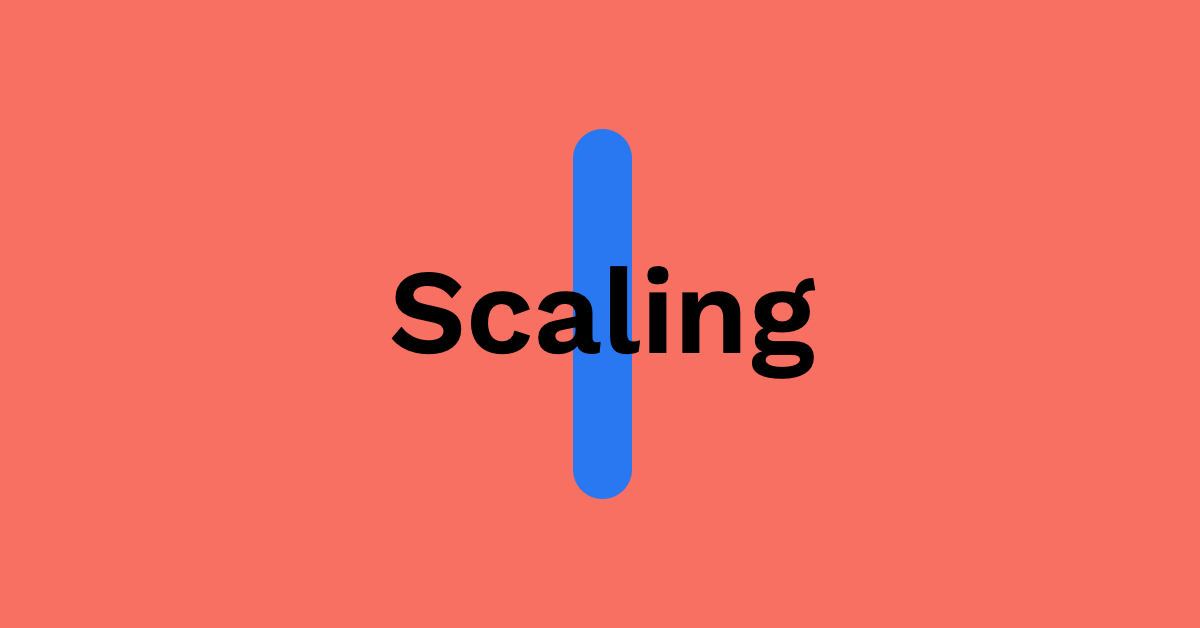
Everything changes rapidly when it comes to making Facebook ads work. Which makes scaling Facebook ad campaigns all the more challenging. If you clicked on this article you obviously know you can’t just increase the budgets.
Not only do you have to adapt your strategies and tactics for changes in Facebook’s algorithm, but you also need to consistently change your ad creatives. It’s a constant cycle of developing winning campaigns and fighting ad fatigue.
The more time you spend analyzing ads, audiences, and metrics, the more impossible the task of scaling Facebook ads seems. But don’t worry…
I’m going to show you seven proven scaling strategies that you can put into action today.
Scaling Tactic #1: Test New Lookalike Audiences 👥
Facebook lookalike audiences are completely new audiences Facebook can create by finding similar people from a given a seed audience. For example, you can have Facebook create a lookalike audience from a CSV list of customers you upload. Lookalike audiences are very powerful in finding new audiences.
Here are some lookalike audiences you can test:
Purchasers from pixel.
This lookalike audience is being built from purchasers with only a 1% audience. The audience size percentages range from 1–10%. A 1% lookalike audience consists of the people most similar to your seed audience. A 10% lookalike audience creates a bigger, broader audience. So in theory, 1% contains new profiles that Facebook thinks is most likely to convert.
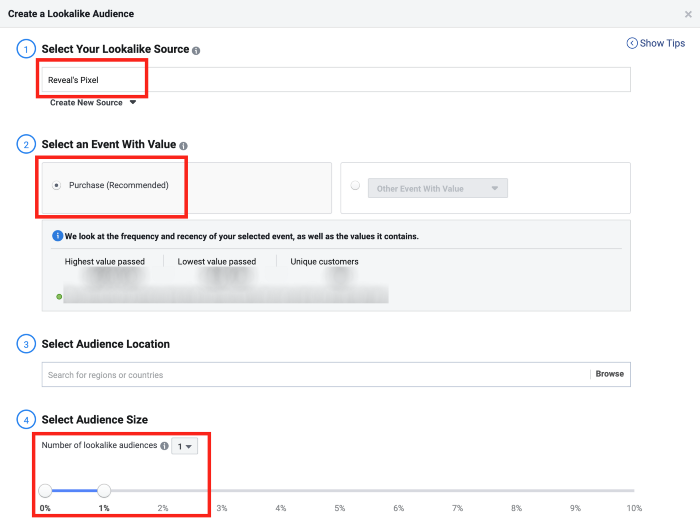
You can create different lookalike audiences for different locations. So depending on your customer demographics, you can easily create several dozen different lookalike audiences like this.
High LTV customers from CRM
If you have a lot of customers in your CRM or database, you can build lookalike audiences of specific segments of your customers instead of all them at once. Export a CSV of your customers and include their life-time-value (LTV), which is the total amount of revenue you’ve received from each person/account.
Then you can use this list as a seed list for a lookalike audience. Facebook will then prioritize your highest LTV customers as seed profiles when building out your lookalike audience. If you’ve never uploaded a CSV list of customers to Facebook, here’s what it looks like.
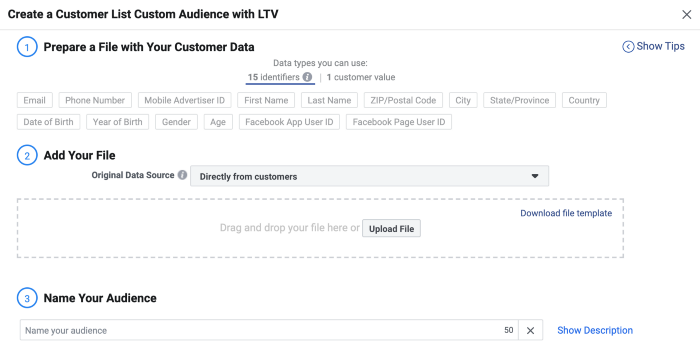
Make sure to include as much information as you can for each person. The more information you have, the more likely Facebook will be able to match your data to Facebook profiles and produce a better lookalike audience.
Scaling Tactic #2: Test New Interest Audiences 🎳
Targeting new interests that you haven’t tried before can be another way to reach new audiences to scale your Facebook ad campaigns. You may already be using some interests for targeting today so this tactic is about finding new interest audiences to target.
Once you have some ideas of new audiences to target, set up new ad sets with your best performing ads. You may need to create new ad creatives that can speak better to your new audiences.
In any case, use automation with the conversion funnel strategy will help you manage your budget across these new audiences so all you have to do is find the audiences and set up the new campaigns and ad sets.
Scaling Tactic #3: Slow and Steady 20% Budget Increases 💸
Increase ad set budgets by 20% every two to three days.
This is a pretty common technique to scale budget and conversions on ad sets. Why does this work? A gradual increase won’t trigger a new learning phase on an ad set compared to a huge increase so its performance will remain more stable. It takes time to grow the budget with this strategy, but the ad set’s life will be longer and with fewer dips in performance.
This tactic is pretty simple to do manually. Just go into Ads Manager and update the ad sets’ budget. Or you can do this automatically in two ways (kinda):
Specific budget increases on ad sets
Using Facebook automated rules, you can create a rule that increases the budget automatically when an ad set meets certain conditions like so:
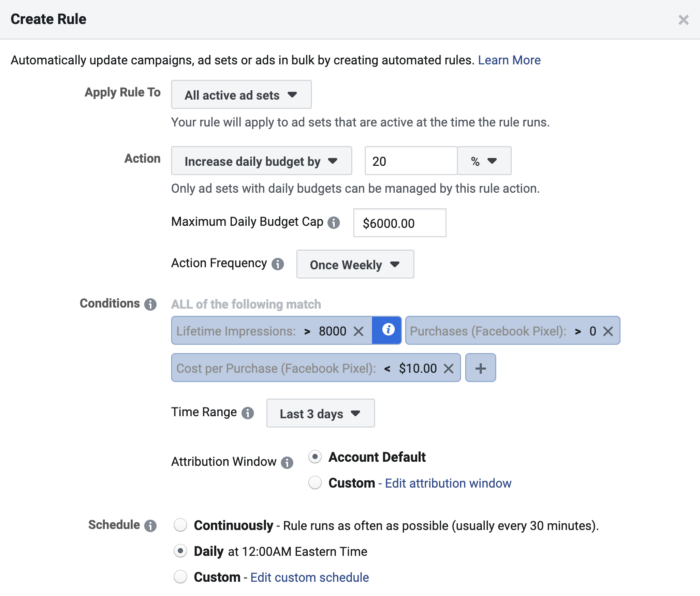
The above automated rule will increase all ad sets’ budgets by 20% once a week up to a maximum daily budget of $6,000 when impressions are over 8,000 and the cost per purchase is under $10 with at least one purchase in the last three days.
You’ll need to modify the maximum daily budget to what you’re comfortable with and change the cost per purchase amount to the maximum cost you can afford. As you may have noticed, the action frequency is set it to “once weekly” because Facebook only allows either daily or weekly — nothing in between.
Auto manage ad set budgets with “Campaign Budget Optimization”
At the end of 2018 Facebook rolled out Campaign Budget Optimization (CBO) which they explain is a new way to control budgets across ad sets. With a CBO enabled campaign, you don’t control the budget at the ad set level and Facebook will distribute the budget you set at the campaign level to the best-performing ad sets.
To enable CBO, you can either create a new campaign or activate it for an existing one in campaign settings. It looks like this:
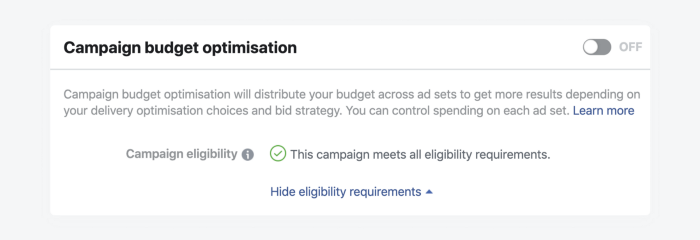
With CBO enabled, you’re now relying on Facebook to distribute the budget to your best-performing ad sets automatically. You’ll be increasing the budget to the high performers and decreasing the budget to the underperformers.
Scaling Tactic #4: Duplicate Successful Ad Sets 💪🏻💪🏻
Duplicate successful ad sets without making any changes to the original one.
Some marketers prefer not to mess with ad sets that are working well and instead launch exact copies of successful ad sets. When duplicating an ad set, create it with a higher budget and now you will have more ad sets that in theory should be successful. Just be aware of the audience overlap as these ad sets will be targeting the same audience.
Once you see an ad set performing well after 24 hours, you can duplicate it at a higher budget. You can do this in Facebook’s Ad Manager manually, but there isn’t a way to automate this process natively with Facebook’s automated rules, but you can create an automated rule to send you a notification to duplicate:
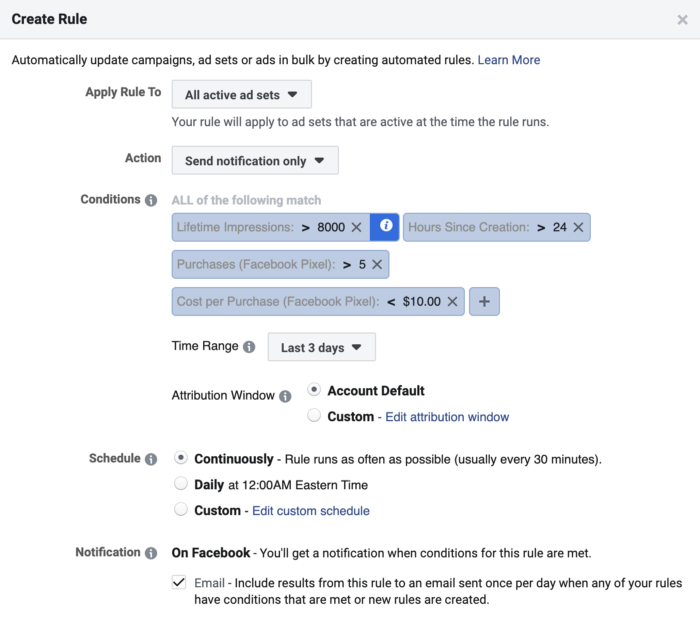
Scaling Tactic #5: Duplicate Unsuccessful Ads 👀
Sometimes a good ad can still get mistreated. You can duplicate an underperforming ad to give it a second chance. I typically change the name so I know it’s the 2nd try.
Again, Facebook’s automated rules can’t duplicate an ad set or an ad, but you can create the same automated rule to notify you I showed above.
Scaling Tactic #6: Securing the lowest manual bid ✅
If you’re using manual bidding and you set the bid too low for an ad to win the auction, the ad set will not be able to spend the budget preventing you from scaling your Facebook ads. If you ever experience low deliverability (measured by low impressions) with a manual bid, you should, therefore, try slightly increasing the bid until it starts getting delivered in the auction.
Here’s how to set it up in Facebook’s native automated rules tool:
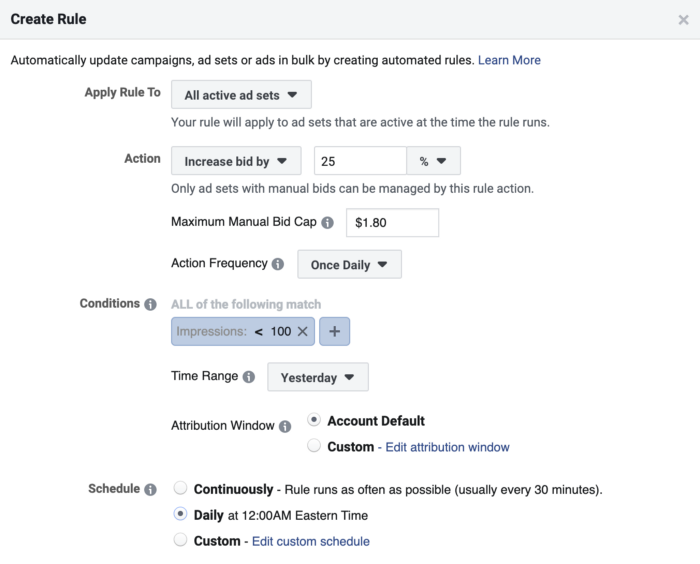
This rule will increase the bid by 25% if an ad has had less than 100 impressions the day before. The only problem I have with this rule is having to wait 24 hours to see if a slight bid increase makes a difference — this is a limit in Facebook’s “time range” capabilities.
When this rule is in place, you can set your manual bid very conservatively without worrying whether you set it too low. You can even set a bid limit in the rule (in the above example it’s a $1.80) so you’ll also know you’ll never bid too much.
In the funnel based strategy, usually you’d set an automated rule to decrease the key metric if performance is poor, but the beautiful part about this strategy is since we’re already only increasing the bid if we’re not getting impressions, we’re already guaranteed the lowest bid. Therefore the reverse of this rule doesn’t necessarily apply.
Scaling Tactic #7: Automatically Increase or Decrease Ad Set Budget Based on Performance 💲
Similar to stop-loss order in stock trading, you can automatically decrease the budget of an ad set if it’s not profitable. Luckily, this is possible in Facebook’s native automated rules tool. In the below rule, the ad set’s daily budget will decrease by 25% (checked daily) if the ad set has spent more than $100 with only two purchases or less. You should change these numbers to fit your business.
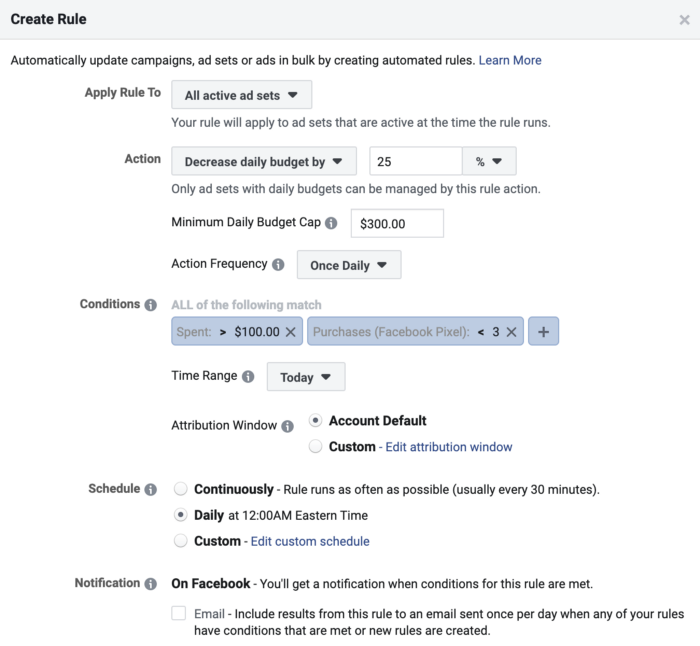
You can also change the condition metrics to be cost per result or website purchase ROAS depending on your campaign and use case. When there is not enough conversion data to make a decision, you can go a step back in the funnel and use add-to-carts instead of something like a purchase event or cost metric.
Then you can do the opposite rule and increase ad set budget by 25% if the ROAS is good. The logic would simply be the opposite:
Increase daily budget by 25% IF
Spent > $100 AND
Purchases (facebook Pixel) > 3
With these two automated rules in place, you’re guaranteeing a level of ROAS you’re comfortable with and automatically accelerating ad sets with high ROAS.
Change ad set budget based on its performance
First, we can decrease the ad set budget the same way, but we can also increase the frequency of how often we want this rule to execute. So instead of only once a day, I can double that frequency and check every twelve hours if purchases also in the last twelve hours is less than two (I’m using small spend and purchase numbers because of the shorter time interval).
And you’ll still need a second rule to increase the budget for ad sets that do well:
Increase daily budget by 25% IF
Spend > $60 AND
Website purchases > 2
Change ad set budget based on overall campaign performance
Another way is to compare the ad set performance with its parent item — something you can’t do in the native Facebook automated rules tool.
Checking a metric against its parent (in this case its campaign) is similar to comparing it to the average sibling (in this case the rest of the ad sets in the parent campaign). The advantage of this setting is that the values are not hard coded and can change depending on the overall performance. Facebook ads are infamous for their volatility, and this type of condition makes the rules adapt to the current performance.
A great use case is decreasing the ad set’s budget (or pausing as shown below) if the ad set’s cost-per-action (CPA) is lower than the average CPA of ad sets in its campaign. For example, let’s say you have three ad sets in one campaign. Each ad set has an overall a CPA of $15, $20, and $35. Therefore the campaign’s average CPA would be $23.30. You can set up a rule that will automatically pause the ad set if its CPA is greater than that of the campaigns. Such a benchmark is especially helpful when you have lots of ad sets, and you’re not sure what threshold to set for your CPA.
What this rule is doing is every twelve hours it will decrease the ad set’s budget by 25% if the ad set has spent over $60, had less than two purchases, and it’s CPA in the last twelve hours is less than one multiple (i.e. equal to) the campaign’s CPA in the last twelve hours.
This example uses CPA, but you can use any key metric you like that matters to your business or particular campaigns, such as ROAS.
Then do the opposite rule to improve ad set budgets when ad sets have a healthy ROAS.
Increase daily budget by 25% IF
Spend > $60 AND
Website purchases > 2 AND
Cost per website purchase > 1 * Cost per website purchase (campaign level)
Experienced marketers, just like Michelin Star Chefs, have their own unique recipes for their campaigns. I believe a good formula for finding your way through is experiment > make mistakes > analyze > automate. And remember: we’re always ready to share our experience and knowledge with you.
If you have your own special technique or recipe for scaling Facebook ads, I’d love to hear it in the comments!

